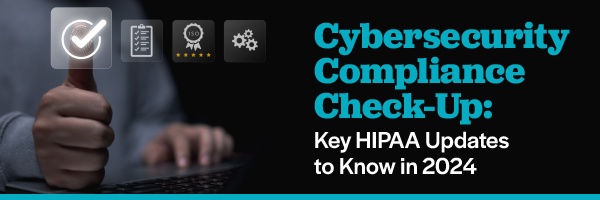
The Cybersecurity Landscape Continues to Evolve for Healthcare Organizations
As a healthcare leader, you know that protecting patient data and ensuring cybersecurity compliance is a never-ending battle. Cyber threats are constantly evolving, and regulations are frequently updated to address new risks. Staying on top of compliance requirements is crucial for avoiding costly penalties, maintaining patient trust, and safeguarding your organization’s reputation.
2024 brings several important cybersecurity compliance updates that healthcare decision-makers need to be aware of. Revisions to HIPAA emphasize that the regulatory landscape is shifting. This blog post will cover the key changes you need to know to keep your organization secure and compliant in the year ahead.
HIPAA Compliance Updates for 2024
HIPAA remains the foundational federal law governing healthcare data privacy and security. While no major overhaul is expected in 2024, there are some important HIPAA compliance updates to be aware of:
Increased Enforcement and Penalties
The Department of Health and Human Services (HHS) has signaled its intent to ramp up HIPAA enforcement actions in 2024. Penalties for non-compliance are also set to increase, with a maximum fine of $1.9 million per violation category per year for large organizations.
Focus on Risk Analysis and Contingency Planning
HIPAA compliance audits in 2024 will heavily emphasize risk analysis and contingency planning requirements. Healthcare organizations must conduct comprehensive risk assessments, document risks, and implement security measures to mitigate identified vulnerabilities. Robust contingency plans for data backup, disaster recovery, and emergency operations will also be scrutinized.
Strengthening Cybersecurity Defenses
Beyond regulatory changes, 2024 will also see continued evolution in cybersecurity threats and best practices for healthcare organizations. Key areas of focus should include:
Bolstering Defenses Against Ransomware Attacks
Ransomware remains one of the top cyber threats facing healthcare, with attacks disrupting operations and putting patient data at risk. Implementing robust backup and recovery solutions, network segmentation, and employee training on ransomware prevention will be critical in 2024.
Enhancing Identity and Access Management (IAM)
As healthcare data becomes more distributed across cloud platforms and remote workforce models expand, IAM will be crucial for controlling access to sensitive information. Deploying multi-factor authentication, privileged access management, and zero trust security frameworks should be priorities.
Addressing Medical Device and IoT Vulnerabilities
The proliferation of connected medical devices and Internet of Things (IoT) technologies in healthcare settings introduces new attack vectors. Comprehensive device inventories, risk assessments, and mitigation strategies will be needed to secure these environments.
Stay Ahead of the Curve
Cybersecurity and HIPAA compliance are challenges that deserve continuous attention from healthcare organizations. By staying informed about key regulatory updates like those outlined above and proactively strengthening your security posture, you can protect your patients’ data, maintain compliance, and mitigate the risks of costly breaches or penalties.
Make 2024 the year you prioritize cybersecurity and data privacy like never before. Invest in robust security solutions, provide comprehensive employee training, and foster a culture of cybersecurity awareness across your organization. The future of your patients’ trust and your organization’s reputation depends on it.

Leave a Reply